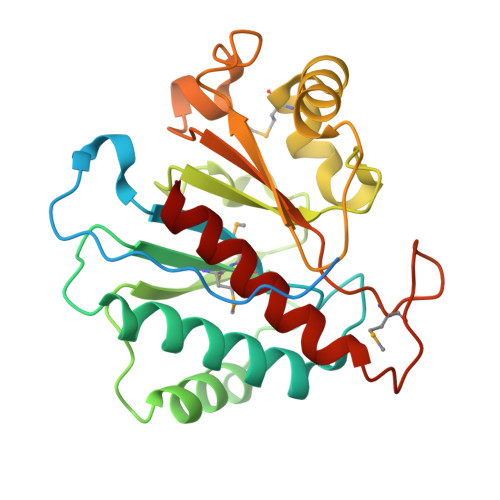The role of ADP-ribosylation in regulating DNA interstrand crosslink repair.
Gunn, A.R., Banos-Pinero, B., Paschke, P., Sanchez-Pulido, L., Ariza, A., Day, J., Emrich, M., Leys, D., Ponting, C.P., Ahel, I., Lakin, N.D.(2016) J Cell Sci 129: 3845-3858
- PubMed: 27587838
- DOI: https://doi.org/10.1242/jcs.193375
- Primary Citation of Related Structures:
5LW0, 5LW6 - PubMed Abstract:
ADP-ribosylation by ADP-ribosyltransferases (ARTs) has a well-established role in DNA strand break repair by promoting enrichment of repair factors at damage sites through ADP-ribose interaction domains. Here, we exploit the simple eukaryote Dictyostelium to uncover a role for ADP-ribosylation in regulating DNA interstrand crosslink repair and redundancy of this pathway with non-homologous end-joining (NHEJ). In silico searches were used to identify a protein that contains a permutated macrodomain (which we call aprataxin/APLF-and-PNKP-like protein; APL). Structural analysis reveals that this permutated macrodomain retains features associated with ADP-ribose interactions and that APL is capable of binding poly(ADP-ribose) through this macrodomain. APL is enriched in chromatin in response to cisplatin treatment, an agent that induces DNA interstrand crosslinks (ICLs). This is dependent on the macrodomain of APL and the ART Adprt2, indicating a role for ADP-ribosylation in the cellular response to cisplatin. Although adprt2 - cells are sensitive to cisplatin, ADP-ribosylation is evident in these cells owing to redundant signalling by the double-strand break (DSB)-responsive ART Adprt1a, promoting NHEJ-mediated repair. These data implicate ADP-ribosylation in DNA ICL repair and identify that NHEJ can function to resolve this form of DNA damage in the absence of Adprt2.
Organizational Affiliation:
Department of Biochemistry, University of Oxford, South Parks Road, Oxford, OX1 3QU, UK.



















